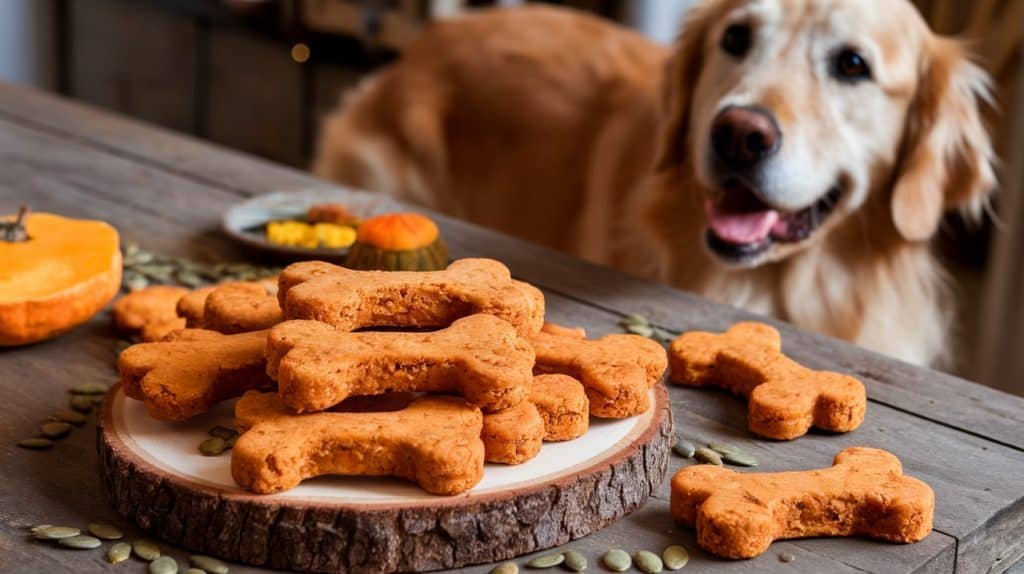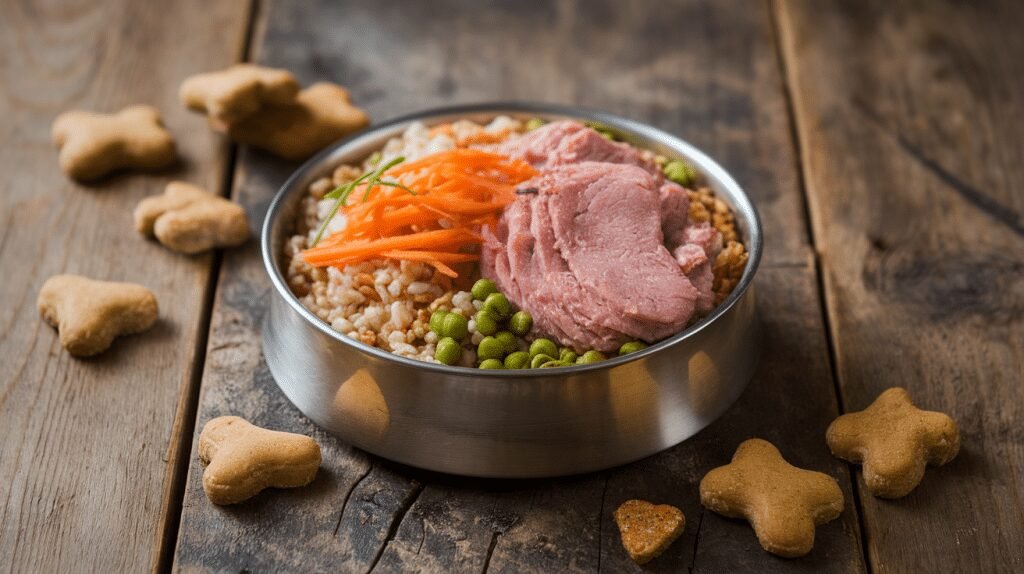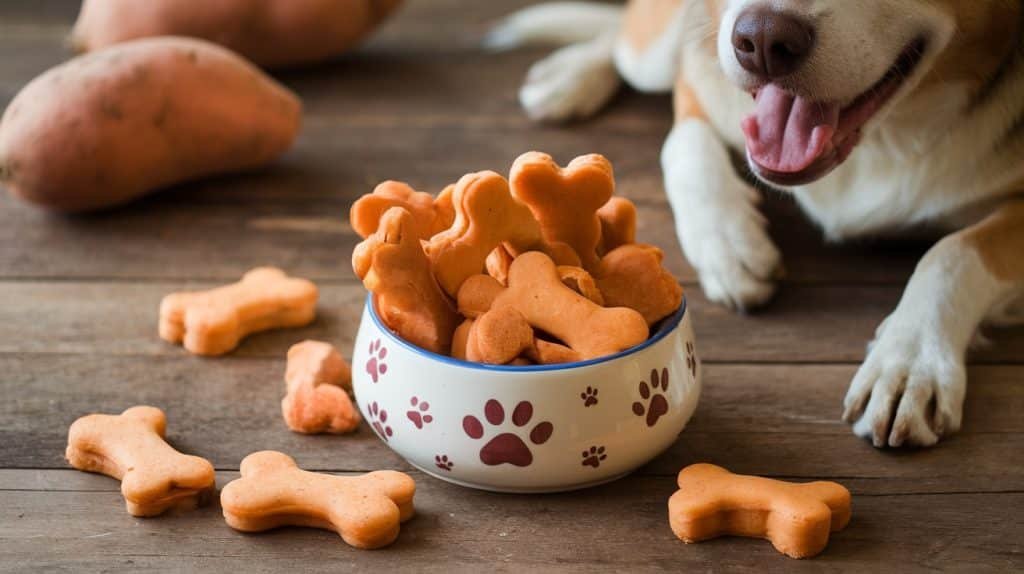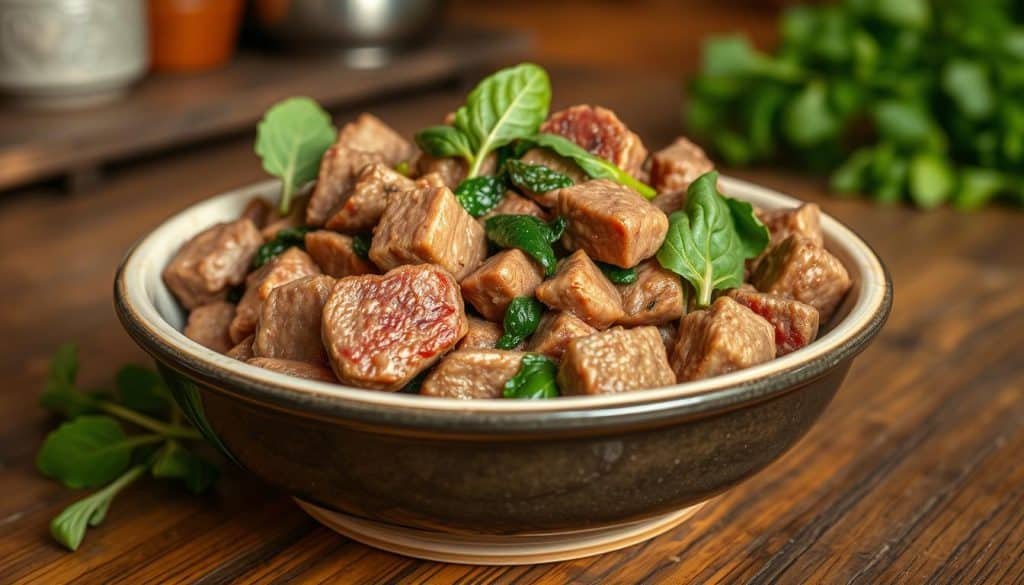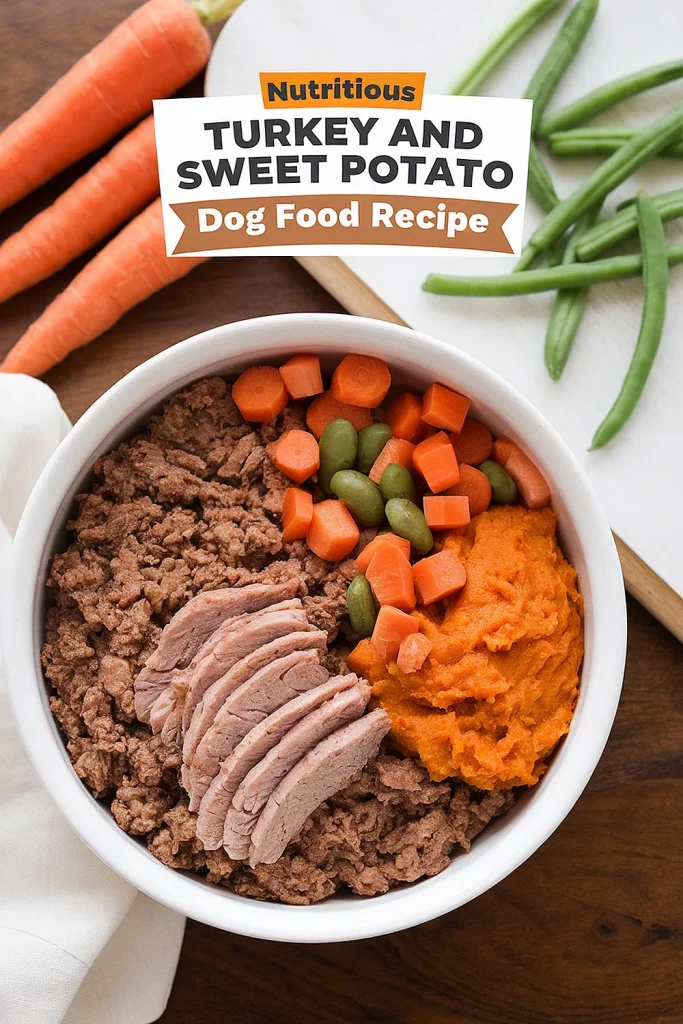
Every evening, as I chopped vegetables for dinner, my furry friend would sit by my feet, eyes wide with anticipation. He loved meal times and I wanted to give him the best. So, I started making homemade dog food, using turkey and sweet potatoes.
This wasn’t just about pleasing his taste buds. It was about making a nutritious meal for him. Seeing him enjoy my cooking was the best reward. Now, I’m excited to share this with other dog lovers.
Why Choose Homemade Dog Food?
Choosing homemade dog food brings many benefits for pet owners and their dogs. When I make my dog’s meals, I know I’m helping their health.
Health Benefits for Your Dog
Homemade dog food is packed with nutrients and no bad fillers. It helps with digestion, skin, and coat health, and weight control. I can adjust the ingredients to fit my dog’s needs, avoiding allergies and ensuring a long, healthy life.
Control Over Ingredients
One big plus of homemade dog food is controlling what goes into it. Unlike store-bought food, which may have artificial stuff, I choose fresh, quality ingredients. This makes sure my dog eats food that’s good for them and tastes great.
Saving Money on Veterinary Bills
Homemade dog food also saves money over time. A balanced diet can prevent health problems like obesity. By choosing healthy ingredients, I save on vet bills and keep my dog and wallet happy.
Turkey and Sweet Potato Dog Food Recipe
Making a healthy meal for my dog is very rewarding. I use key ingredients for this turkey and sweet potato recipe. Each one helps keep my dog healthy.
Ingredients You’ll Need
- 1 pound ground turkey
- 1 cup sweet potato, peeled and cubed
- 1/2 cup carrots, diced
- 1/2 cup peas, frozen or fresh
- 1 tablespoon olive oil
- 1/4 cup chicken broth (low sodium)
This mix of ingredients makes a tasty and nutritious meal. Ground turkey is a great protein for muscles. Sweet potatoes add vitamins A and C for immune health and fiber for digestion.
Carrots and peas bring more vitamins and minerals. This recipe is a complete meal for my dog.
Nutrition Breakdown
| Ingredient | Nutritional Benefits |
|---|---|
| Ground Turkey | High in protein, supports muscle growth and repair (turkey dog food nutrition). |
| Sweet Potato | Rich in vitamins A and C, promotes eye health and digestion (sweet potato health benefits). |
| Carrots | Provides Vitamin A for healthy skin and vision. |
| Peas | Contains antioxidants and additional vitamins, aiding immune function. |
| Olive Oil | Healthy fats for a shiny coat and overall health. |
| Chicken Broth | Enhances flavor and adds hydration without excessive sodium. |
Step-by-Step Instructions for Cooking
Cooking homemade dog food is fun and rewarding. It takes about 10 minutes to prepare, including getting all the ingredients ready and chopping veggies. I’ll show you how to cook dog food step by step for the best results.
Prep Time and Ingredients Prep
- Gather the following ingredients:
- 1 pound ground turkey
- 1 cup diced sweet potato
- 1/2 cup diced carrots
- 1/2 cup peas (frozen or fresh)
- 1 cup chicken broth (low sodium)
- 1 tablespoon olive oil
- Chop the sweet potato and carrots into small, even pieces. This ensures they cook uniformly during the cooking process.
Cooking Process
First, heat the olive oil in a large skillet over medium heat. Add the ground turkey and stir occasionally until it’s browned. Then, mix in the diced sweet potato, carrots, and chicken broth in the skillet.
Bring this mixture to a boil, then reduce the heat to a simmer. Let it cook for about 20 minutes, until the sweet potatoes are tender. In the last 5 minutes, add the peas to keep them crunchy. This makes sure the food is both healthy and tasty for my dog.
Cooling and Serving Recommendations
After cooking, remember to cool the food completely before serving. This protects my dog’s sensitive mouth and ensures safe eating. I portion the food based on my dog’s size and activity level. This makes it easy to manage and helps in switching to homemade food smoothly.
Understanding Dog Nutritional Needs
Knowing what my dog needs in their diet is key. It helps me choose the right food for them. Every dog is different, but good nutrition is crucial for their health and happiness.
Essential Nutrients for Dogs
Dogs need a balanced diet that includes:
- Proteins – For muscle health and repair.
- Fats – To provide energy and support skin and coat health.
- Carbohydrates – For energy and digestive health.
- Vitamins – Essential for metabolic processes.
- Minerals – Important for bone health and physiological functions.
These nutrients help keep dogs healthy, active, and prevent diseases.
How Turkey and Sweet Potato Benefit Your Pup
Turkey and sweet potatoes are great for dogs. Turkey has lots of protein for muscles and vitamins for energy. Sweet potatoes are full of fiber for digestion and energy.
Adding these to my dog’s meals meets their nutritional needs. It boosts their health and happiness.
Storage Tips for Homemade Dog Food
After making homemade dog food, keeping it fresh is key. I’ve found some great tips to keep my dog’s meals safe and tasty. These tips help ensure every meal is a good one.
How to Properly Store Leftovers
Storing homemade dog food right is important. Use airtight containers to keep it fresh in the fridge for 3-4 days. Here are some tips for storing your dog’s food:
- Let the food cool down before putting it in airtight containers.
- Write the date on the containers so you know how long it’s been stored.
- Put the food in the back of the fridge for better temperature control.
These steps help avoid contamination and keep the food safe for your dog.
Freezing Options for Longer Shelf Life
Freezing is a great way to keep dog food longer. I portion the food into smaller servings for easier thawing. Here’s how to freeze your dog’s food:
- Cool the cooked food completely and divide it into portions.
- Put the portions in freezer-safe containers or bags, squeezing out air.
- Mark the containers or bags with the date and what’s inside.
- Freeze the portions for up to 2-3 months.
To thaw frozen food, put it in the fridge overnight. For quicker thawing, use the microwave on defrost mode. Just mix well and check for hot spots before serving.
Customization Options for Your Dog’s Taste
Customizing dog food lets me tailor my pup’s diet to their taste and needs. I can add flavor safely by using veggies and turkey substitutes. This way, I give them a varied and tasty diet.
Adding Safe Vegetables and Seasonings
Adding veggies like spinach or zucchini makes food taste better and is healthier. I also use dog-safe herbs like parsley or basil. These add flavor without harming my dog. Here are some safe options:
- Carrots
- Broccoli
- Peas
- Sweet potatoes
- Parsley
- Basil
Alternatives to Turkey
When turkey isn’t available or my dog doesn’t like it, I have other protein choices. Chicken, lamb, and fish are great alternatives. They provide the nutrients my dog needs. Here’s a comparison:
| Protein Source | Benefits | Possible Allergies |
|---|---|---|
| Chicken | Rich in protein and easily digestible | Common allergen for some dogs |
| Lamb | Good for dogs with sensitivities | Lower allergenic potential |
| Fish | High in omega-3 fatty acids for skin and coat health | May cause reactions in some dogs |
Customizing dog food is fun. It lets me try different flavors and make sure my dog loves their meals.

Feeding Guide: How Much to Serve
Finding the right amount of dog food is key to my dog’s health and happiness. I look at their weight, age, and how active they are. Active dogs need more food than older or less active ones.
A good starting point is 2-3% of their body weight each day. This is split into two meals.
Calculating Portion Sizes
I adjust the food amounts based on my dog’s needs. For example, a 40-pound dog might get 0.8 to 1.2 pounds of homemade food daily. If they’re gaining or losing weight, I change the portions slowly. This keeps their diet balanced and healthy.
Transitioning to Homemade Dog Food
Switching to homemade food needs to be done slowly to avoid stomach problems. I plan a week-long transition. I start with 25% homemade food and 75% of their regular food.
By the end of the week, they’re ready for all homemade food. They feel great and adjust well to the new diet!


